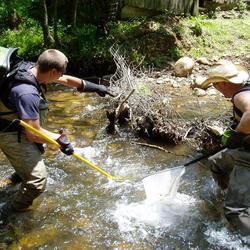Aquatic Connectivity
Aquatic Connectivity
Filter Total Items: 11
EESC Makes an Impact: Enhancing Recreational & Commercial Fishing
The USGS Eastern Ecological Science Center (EESC) provides world-class science to inform natural resource decisions on aquatic ecosystems, species populations and management, disease, and invasive species. Our scientific products represent critical contributions that enhance the ecological and economic sustainability of recreational and commercial fishing. In the United States, anglers contribute...
Genomics to Aid Conservation and restoration of the Yellow Lampmussel (Lampsilis cariosa) and Tidewater Mucket (Atlanticoncha ochracea)
Due to the rapid decline in abundance of Yellow Lampmussel ( Lampsilis cariosa) and Tidewater Mucket ( Atlanticoncha ochracea), USGS and partners at the U.S. Fish and Wildlife Service (USFWS) and Central Michigan University (CMU) are conducting an assessment of genetic diversity and population structure to inform appropriate recommendations for conservation and management of each species. These...
Alosine Genetic Stock Identification and Tissue Repository
American Shad ( Alosa sapidissima), Blueback Herring ( Alosa aestivalis), and Alewife ( Alosa pseudoharengus; collectively “alosines”) once supported large fisheries along the U.S. Atlantic Coast. However, impassable migration barriers, declines in habitat quality, and exploitation have led to declines in many spawning populations. Substantial resources have been invested to support the recovery...
Fish Passage Research to Identify the Ideal Fishway Entrance for River Herring (Alosa spp)
USGS is working to identify an improved fishway entrance design for two at-risk species, blueback herring ( Alosa aestivalis) and alewife ( Alosa pseudoharengus).
Development and Evaluation of the Novel East Coast Fish Ladder
USGS is working to establish a new East Coast fish ladder design that would help a multitude of aquatic species move easier in our waterways.
Production, Behavior, and Survival of Juvenile Shad and River Herring
USGS is conducting research to better understand biology, behavior, and survival of juvenile fishes that travel between fresh and saltwater to complete their lifecycles. Migratory fishes as such as herring and shad are vital components in riverine and coastal ecosystems, transporting food and nutrients between fresh rivers and the ocean. They are also an important forage fish for predators in...
Using Multiple Indicators to Assess Stream Condition in the Chesapeake Bay
USGS is working with federal, state and local partners to develop multiple assessments of stream and river conditions in non-tidal areas of the Chesapeake Bay watershed. These assessments will help managers preserve stream health and improve biological conditions in impaired streams as the human population and climate continue to change in this region.
New studies reveal ecological importance of fine-scale groundwater connectivity for streams during drought
Stream ecosystems support vital resources that may be jeopardized by climate change and climate stressors such as drought.
Advancing the Environmental DNA Toolkit for Ecosystem Monitoring and Management
The emerging field of Environmental DNA (eDNA) analysis allows characterization of species presence and community biodiversity by identifying trace amounts of genetic material left behind as organisms move through their environments. EESC scientists have been using eDNA technologies to detect native and rare species and as community biomonitoring tools.
Northeast Amphibian Research and Monitoring Initiative
The U.S. Geological Survey’s Eastern Ecological Science Center is home to the Northeast Amphibian Research and Monitoring Initiative (NEARMI), one of 7 ARMI regions across the United States. NEARMI works on public lands in thirteen states from Maine to Virginia, including many National Parks and National Wildlife Refuges.
Eastern Ecological Science Center partnership with Atlantic States Marine Fisheries Commission
Collaboration between the world-class expertise of USGS scientists, the Atlantic States Marine Fisheries Commission’s Science Program, and state and federal fishery agencies demonstrates the power of partnerships to solve seemingly-insurmountable problems in sustainable and cooperative management of Atlantic coastal fisheries.












